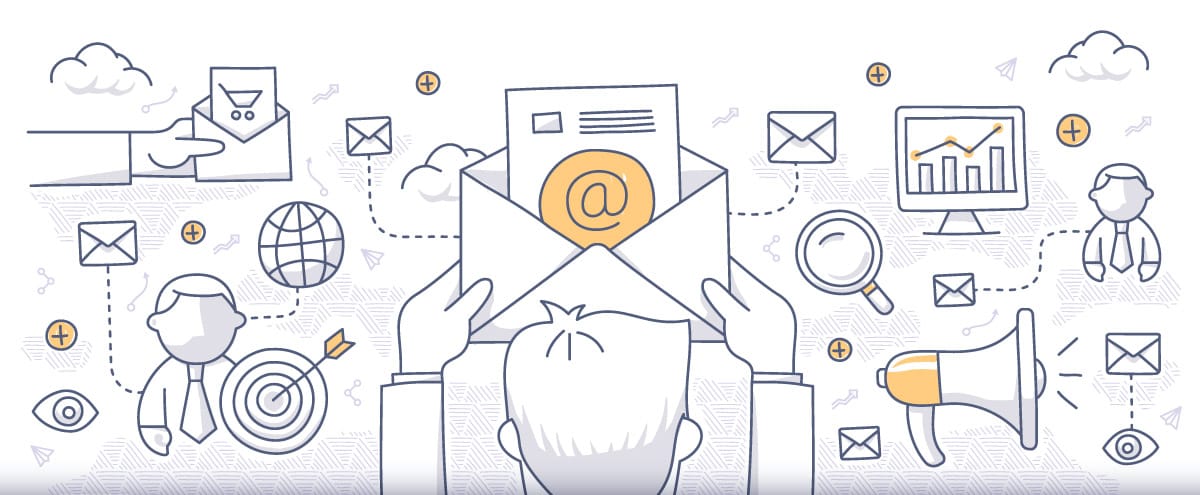Whether you are just now considering email marketing or seriously need to revamp the process, 2022 is the time to get started. Emails have never been more crucial to the success of your marketing strategy.
Sending the right message to the right person at the right time is a vital part of connecting with your audience in a way that builds trust. This blog will dive into why email marketing strategy should be a top 2022 business resolution and how you can get started.
What is Email Marketing?

In 1998, Constant Contact created the first email marketing tool, enabling companies to connect with their audiences through the inbox. A lot has changed since then—especially the potential effectiveness of those emails. Email marketing campaigns are used to fuel inbound marketing. Brands can use emails to be personal and helpful to their target audiences.
Email is a conversational tool that creates meaningful interactions when used strategically. There are three key pieces to creating the kind of content that best represents powerful email marketing:
List Segmentation – Sending a relevant email, appealing to the right person with the right message at the right time, means you have to know your list. Emails shouldn’t be one-size-fits-all content pieces. Don’t waste the time of your readers or they won’t value your messages. List segmentation comes down to the buyer’s journey and buyer personas which we will discuss more below.
Content Personalization – The context of what you send is as valuable as the content. Personalization goes far beyond just adding a lead’s name to the email subject line. Machine-learning and data-based features can provide an individualized experience that leads to a higher value for your contacts. Personalization stems from on customer activity, past purchases and more.
Strategy Analysis – Companies that don’t change become stagnant. Learn how to evolve with constantly changing customers by practicing continual assessments and adjustments to your campaigns. Establish the key metrics to track that best represent essential benchmarks for success according to your goals. This requires understanding individual metrics and finding the right ones for your brand. With this information in hand, continually optimize and improve your emails for an effective strategy.
Email marketing can include campaigns, automated emails and any other pieces of the email strategy for your brand. Your emails should go hand-in-hand with your inbound marketing strategy. These strategies should focus primarily on the value you offer—not the value you are after. The audience comes first in this customer-centric approach.
Why Should I Use Email Marketing?

Email campaigns from brands have been around for more than two decades, so you might wonder, “Is email marketing still effective?” Many brand leaders wonder if they should spend their precious time and limited marketing budgets on robust email marketing strategies. The answer is a resounding yes.
According to HubSpot statistics:
- More than 4 billion users are checking email daily, including many on the smartphone.
- 78% of marketers saw an increase in email engagement over the past year.
- 74% of Boomers say email is the most personal channel for brand communication.
- Email leads to $42 in revenue for every $1 spent on creation—which is 4,200% ROI!
However, it is important to note: your ROI is not guaranteed. Not all emails are the same, so success will come down to your strategy and implementation.
What Makes Branded Emails Effective?
Email marketing helps brands form a connection with their audiences for increased sales and loyalty. When implemented correctly, email marketing will help:
Develop Relationships – Brands can be more authentic and relational by using different channels in different ways. For example, while some social media will help brands display their day-to-day realities, emails can be used to tell a brand story, introduce new products, highlight events and offer specific value to their leads.
Build Trust – When a brand uses their email to support customers and build a relationship, they build trust. Brands that honor their audience and respect their time show themselves to be a company worth trusting.
Offer Value – Strong email marketing tactics can help customers feel seen and valued at every stage of the buyer’s journey. Brands can introduce themselves to leads in the awareness stage, support the consideration stage, prompt a decision and then offer customer support after the point of sale.
High-performing emails drive engagement. You have to deliver the right message to the right parts of your audience at the right moment in their journey.
7 Tips for Getting Started with Email Marketing

If you are ready to start sending out emails or want to improve your current approach, there is no better time than the present. Start the year off right with a focus on developing an email marketing strategy centered around your business goals.
People are expecting more from brands than ever before. After two years of navigating a pandemic, customers are looking for brands they can connect with and trust on an even deeper level. People want solid communication, authenticity and to be treated as more than a wallet.
Create a serious email marketing strategy to increase sales and boost growth with these seven tips.
Choose an Email Service Provider
First and foremost, you will need an email provider, like Mailchimp, Constant Contact, Gmail, or Bluehost. The right email service provider connects to your contact database and analyzes results to improve your strategies.
You want to choose an email provider that integrates easily with your other tools—like your CRM (customer relationship management) software. Email providers for businesses typically provide email marketing templates to keep your content consistent and visually engaging. Tracking features and analytics can be helpful here as well.
Establish Your Contact Database
Building your contacts list is going to be the next step in your email marketing strategy. If you’ve started building your list, then you will want to audit what you already have. It might seem counter-intuitive, but it is better to thin your list down to only the contacts who want to get content from your brand.
For this reason, you NEVER want to purchase contact lists.
Some brands want to grow quickly, so they try to buy names and emails of people who could be in their target audience. This is a self-sabotaging move that will land you in a heap of trouble. If you’ve purchased a list, you need to remove them now.
Most marketing vendors will outline rules that are violated with purchased lists. Collect consent ALWAYS (this includes explicit permissions and setting expectations on the content/frequency of your emails). Stay in compliance with the General Data Protection Regulation by collecting this consent with opt-ins.
To help solidify these opted-in contacts as willing participants on your list, send an email immediately to introduce your brand and clarify why you are emailing them (keep it in line with why they signed up in the first place. You don’t want to let time pass because they may forget why they signed up or how you connected in the first place.
Single Opt-In (SOI) vs. Double-Opt-In (DOI)
It used to be encouraged that brands create a double opt-in process for their contacts. However, Litmus found SOI had an 80% higher return than DOI strategies; in cases of explicit consent, a single opt-in is more the effective strategy.
If consent isn’t explicit, you can confirm with a second opt-in. For example, if you participate in an event where users sign up or inherit an email list, you don’t have explicit consent to email them. You can send a follow-up email after the event to explain your marketing intentions and request the explicit opt-in moving forward.
Maintain a Healthy Database
It is better to remove contacts that aren’t interested in what you offer than have a larger list bloated with valueless contacts.
As you are building a healthy database, it’s also important to remember that your contacts list will decay every year. Estimates are that lists may deteriorate as quickly as 20% – 30% each year. So, not only should you be watching for telltale signs of irrelevant addresses, but you should keep growing your list to mitigate the decay.
Signs of decayed list segments include low engagement levels (click-throughs), nonexistent open rates, or spam reports.
This might occur because a contact no longer needs your products/services, they didn’t expect the type/volume of messages or they forget signing up in the first place. Elevated bounce rates, unsubscribes, and spam reports hurt domain reputation, increasing the risk of your emails going straight to spam.
Develop and Store Data for Segmentation
Segmented emails led to as much as a 760% increase in revenue.
Contextual emails take into account the individual’s point in the buyer’s journey and buyer persona details to send them only appealing content. This information could come from web forms, surveys, web behavior, purchase history, and more.
Your CRM should track each contact’s interaction with your brand, point in the buyer’s journey, demographics, professional title, industry, gender, location, and anything else that might impact which messages are most likely to resonate with them.
Your list consists of subscribers, qualified leads, and customers. A subscriber at the beginning of the buyer’s journey (just entering awareness) should not receive the same emails as a loyal customer who might be interested in a tutorial or related product.
Define Company Goals
Before you write any content, you need to determine your why.
Why are you sending out emails? What exactly do you want to accomplish? What value are you offering?
There is a difference between marketing goals and company goals. First, set your company goals to know exactly what you hope to accomplish in 2022 with well-defined SMART (specific, measurable, attainable, realistic, timely) goals. Then, determine how your marketing strategies can achieve those goals, taking into account the needs of your audience.
Within your marketing strategy, determine how emails will play a role. What specific actions can you encourage that will support your goals? How is the customer being served in this process?
Without a clear goal, your messaging will be weak and lack direction. The customer won’t know why you are sending the email and won’t participate in actions you want them to take.
Remember, conversion isn’t just related to sales—conversion is getting a lead to complete any desired action you have established as a goal. Possible conversions include opting into an email list, sharing your brand on social media, posting a positive review, or clicking to view a linked blog post. Your CTA (call to action) determines the conversion metric for each email.
Send VALUE
 Every email should offer the audience value. Personalization is one of the best ways to provide this value on an individual basis. To create an enticing offer, use a funnel-down design approach with the AIDA model (attention, interest, desire, and action).
Every email should offer the audience value. Personalization is one of the best ways to provide this value on an individual basis. To create an enticing offer, use a funnel-down design approach with the AIDA model (attention, interest, desire, and action).
- Headlines grab attention to increase open rates.
- Interest is created with the messaging and images inside aligning with that headline.
- Desire occurs because the right audience is being targeted with an appealing offer.
- Action is provoked with a single, targeted CTA (call to action) for a clear directive.
Use clean, straightforward design with on-brand templates to help organize your content and adapt it to various screen formats. HubSpot reports that nearly 20% of emails are not optimized for mobile, even though 55% of web traffic is done on smartphones.
Always check screen adaptions by sending your email to yourself to check on a laptop/desktop, tablet, and smartphone. Proofread your work and make sure images are compressed. You don’t want to lose trust over something as small as a typo or broken link.
Finally, make sure you are in CAN-SPAM compliance by including your physical address and unsubscribe link in the footer of the email.
Test, Analyze, and Adjust
Don’t rely on your first attempt to be the right approach. Brands use A/B testing to determine the right direction for appealing headlines, images, layouts and more. What works all comes down to your audience and brand, and many companies do not follow the same approach.
If you need help with your content marketing, emails, and testing, our expert marketing team can help. Reach out and request a quote today.











